JVM_08 类加载与字节码技术(字节码指令2)
Posted 兴趣使然の草帽路飞
tags:
篇首语:本文由小常识网(cha138.com)小编为大家整理,主要介绍了JVM_08 类加载与字节码技术(字节码指令2)相关的知识,希望对你有一定的参考价值。
1.条件判断指令
| 指令 | 助记符 | 含义 |
|---|---|---|
| 0x99 | ifeq | 判断是否 == 0 |
| 0x9a | ifne | 判断是否 != 0 |
| 0x9b | iflt | 判断是否 < 0 |
| 0x9c | ifge | 判断是否 >= 0 |
| 0x9d | ifgt | 判断是否 > 0 |
| 0x9e | ifle | 判断是否 <= 0 |
| 0x9f | if_icmpeq | 两个int是否 == |
| 0xa0 | if_icmpne | 两个int是否 != |
| 0xa1 | if_icmplt | 两个int是否 < |
| 0xa2 | if_icmpge | 两个int是否 >= |
| 0xa3 | if_icmpgt | 两个int是否 > |
| 0xa4 | if_icmple | 两个int是否 <= |
| 0xa5 | if_acmpeq | 两个引用是否 == |
| 0xa6 | if_acmpne | 两个引用是否 != |
| 0xc6 | ifnull | 判断是否 == null |
| 0xc7 | ifnonnull | 判断是否 != null |
几点说明:
- byte,short,char 都会按 int 比较,因为操作数栈都是 4 字节
- goto 用来进行跳转到指定行号的字节码
案例源码:
public class Demo3_3 {
public static void main(String[] args) {
int a = 0;
if(a == 0) {
a = 10;
} else {
a = 20;
}
}
}
字节码:
0: iconst_0
1: istore_1
2: iload_1
3: ifne 12
6: bipush 10
8: istore_1
9: goto 15
12: bipush 20
14: istore_1
15: return
思考:细心的同学应当注意到,以上比较指令中没有 long,float,double 的比较,那么它们要比较怎么办?
参考 https://docs.oracle.com/javase/specs/jvms/se7/html/jvms-6.html#jvms-6.5.lcmp
2.循环控制指令
其实循环控制还是前面介绍的那些指令,例如 while 循环:
public class Demo3_4 {
public static void main(String[] args) {
int a = 0;
while (a < 10) {
a++;
}
}
}
字节码是:
0: iconst_0
1: istore_1
2: iload_1
3: bipush 10
5: if_icmpge 14
8: iinc 1,1
11: goto 2
14: return
再比如 do while 循环:
public class Demo3_5 {
public static void main(String[] args) {
int a = 0;
do {
a++;
} while (a < 10);
}
}
字节码是:
0: iconst_0
1: istore_1
2: iinc 1, 1
5: iload_1
6: bipush 10
8: if_icmplt 2
11: return
最后再看看 for 循环:
public class Demo3_6 {
public static void main(String[] args) {
for (int i = 0; i < 10; i++) {
}
}
}
字节码是:
0: iconst_0
1: istore_1
2: iload_1
3: bipush 10
5: if_icmpge 14
8: iinc 1, 1
11: goto 2
14: retur
注意:比较 while 和 for 的字节码,你发现它们是一模一样的,殊途也能同归
练习 - 判断结果
请从字节码角度分析,下列代码运行的结果:
public class Demo3_6_1 {
public static void main(String[] args) {
int i = 0;
int x = 0;
while (i < 10) {
x = x++;
i++;
}
System.out.println(x); // 结果是 0
}
}
4. 构造方法
< cinit>()V 类的构造方法
public class Demo3_8_1 {
static int i = 10;
static {
i = 20;
}
static {
i = 30;
}
}
编译器会按从上至下的顺序,收集所有 static 静态代码块和静态成员赋值的代码,合并为一个特殊的方法 < cinit>()V :
0: bipush 10 // 对应 i = 10
2: putstatic #2 // Field i:I
5: bipush 20
7: putstatic #2 // Field i:I
10: bipush 30
12: putstatic #2 // Field i:I
15: return
< cinit>()V 方法会在类加载的初始化阶段被调用
上述代码最终结果 i的值是30!
练习:同学们可以自己调整一下 static 变量和静态代码块的位置,观察字节码的改动
< init>()V 实例对象构造方法
public class Demo3_8_2 {
private String a = "s1";
{
b = 20;
}
private int b = 10;
{
a = "s2";
}
public Demo3_8_2(String a, int b) {
this.a = a;
this.b = b;
}
public static void main(String[] args) {
Demo3_8_2 d = new Demo3_8_2("s3", 30);
System.out.println(d.a);// s3
System.out.println(d.b);// 30
}
}
编译器会按从上至下的顺序,收集所有 {} 代码块和成员变量赋值的代码,形成新的构造方法,但原始构造方法内的代码总是在最后:
public cn.itcast.jvm.t3.bytecode.Demo3_8_2(java.lang.String, int);
descriptor: (Ljava/lang/String;I)V
flags: ACC_PUBLIC
Code:
stack=2, locals=3, args_size=3
0: aload_0
1: invokespecial #1 // super.<init>()V
4: aload_0
5: ldc #2 // <- "s1"
7: putfield #3 // -> this.a
10: aload_0
11: bipush 20 // <- 20
13: putfield #4 // -> this.b
16: aload_0
17: bipush 10 // <- 10
19: putfield #4 // -> this.b
22: aload_0
23: ldc #5 // <- "s2"
25: putfield #3 // -> this.a
28: aload_0 // ------------------------------
29: aload_1 // <- slot 1(a) "s3" |
30: putfield #3 // -> this.a |
33: aload_0 |
34: iload_2 // <- slot 2(b) 30 |
35: putfield #4 // -> this.b --------------------
38: return
LineNumberTable: ...
LocalVariableTable:
Start Length Slot Name Signature
0 39 0 this Lcn/itcast/jvm/t3/bytecode/Demo3_8_2;
0 39 1 a Ljava/lang/String;
0 39 2 b I
MethodParameters: ...
5.方法调用
看一下几种不同的方法调用对应的字节码指令:
public class Demo3_9 {
public Demo3_9() { }
private void test1() { }
private final void test2() { }
public void test3() { }
public static void test4() { }
public static void main(String[] args) {
Demo3_9 d = new Demo3_9();
d.test1();
d.test2();
d.test3();
d.test4();
Demo3_9.test4();
}
}
字节码:
0: new #2 // class cn/itcast/jvm/t3/bytecode/Demo3_9
3: dup
4: invokespecial #3 // Method "<init>":()V
7: astore_1
8: aload_1
9: invokespecial #4 // Method test1:()V
12: aload_1
13: invokespecial #5 // Method test2:()V
16: aload_1
17: invokevirtual #6 // Method test3:()V
20: aload_1
21: pop
22: invokestatic #7 // Method test4:()V
25: invokestatic #7 // Method test4:()V
28: return
- new 是创建【对象】,给对象分配堆内存,执行成功会将【对象引用】压入操作数栈。
- dup 是赋值操作数栈栈顶的内容,本例即为【对象引用】,为什么需要两份引用呢,一个是要配合 invokespecial 调用该对象的构造方法 “< init>”: ()V (会消耗掉栈顶一个引用),另一个要配合 astore_1 赋值给局部变量。
- 最终方法(final),私有方法(private),构造方法都是由 invokespecial 指令来调用,属于静态绑定。
- 普通成员方法是由 invokevirtual 调用,属于动态绑定,即支持多态。
- 成员方法与静态方法调用的另一个区别是,执行方法前是否需要【对象引用】。
- 比较有意思的是 d.test4(); 是通过【对象引用】调用一个静态方法,可以看到在调用。invokestatic 之前执行了 pop 指令,把【对象引用】从操作数栈弹掉了。
- 还有一个执行 invokespecial 的情况是通过 super 调用父类方法。
6. 多态的原理
/**
* -XX:-UseCompressedOops -XX:-UseCompressedClassPointers
*/
public class Demo3_10 {
public static void test(Animal animal) {
animal.eat();
System.out.println(animal.toString());
}
public static void main(String[] args) throws IOException {
test(new Cat());
test(new Dog());
System.in.read();
}
}
abstract class Animal {
public abstract void eat();
@Override
public String toString() {
return "我是" + this.getClass().getSimpleName();
}
}
class Dog extends Animal {
@Override
public void eat() {
System.out.println("啃骨头");
}
}
class Cat extends Animal {
@Override
public void eat() {
System.out.println("吃鱼");
}
}
1)运行代码
停在 System.in.read() 方法上,这时运行 jps 获取进程 id
2)运行 HSDB 工具,进入 JDK 安装目录,执行:
java -cp ./lib/sa-jdi.jar sun.jvm.hotspot.HSDB
进入图形界面 attach 进程 id,打开 Tools -> Find Object By Query:
输入 select d from cn.itcast.jvm.t3.bytecode.Dog d 点击 Execute 执行
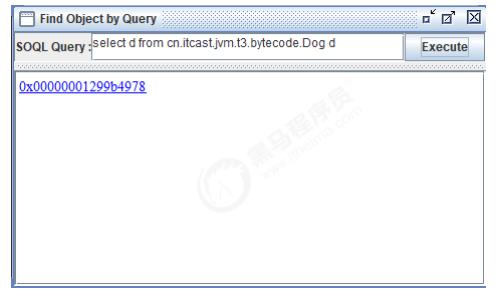
4)查看对象内存结构
点击超链接可以看到对象的内存结构,此对象没有任何属性,因此只有对象头的 16 字节,前 8 字节是
MarkWord,后 8 字节就是对象的 Class 指针,但目前看不到它的实际地址
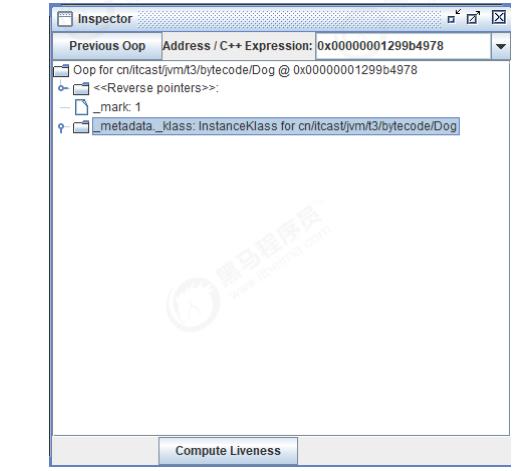
可以通过 Windows -> Console 进入命令行模式,执行
mem 0x00000001299b4978 2
mem 有两个参数,参数 1 是对象地址,参数 2 是查看 2 行(即 16 字节)
结果中第二行 0x000000001b7d4028 即为 Class 的内存地址
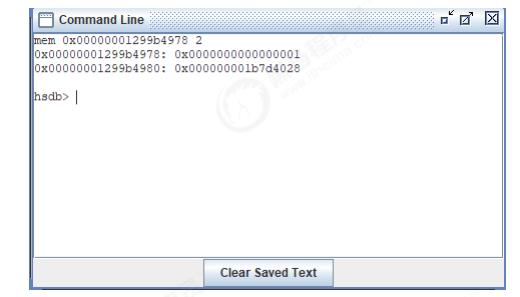
6)查看类的 vtable
- 方法1:Alt+R 进入 Inspector 工具,输入刚才的 Class 内存地址,看到如下界面
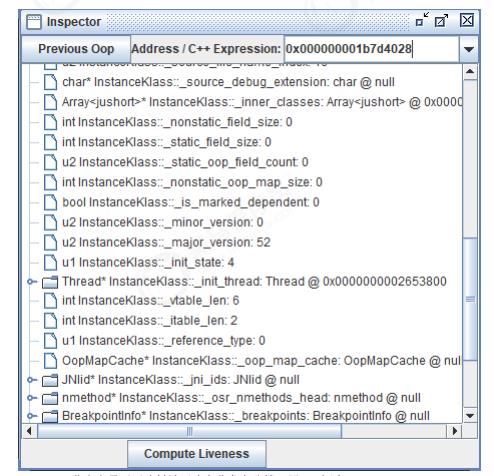
- 方法2:或者 Tools -> Class Browser 输入 Dog 查找,可以得到相同的结果
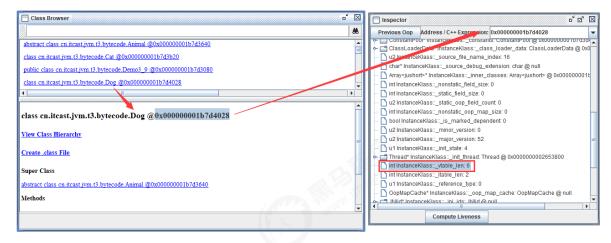
无论通过哪种方法,都可以找到 Dog Class 的 vtable 长度为 6,意思就是 Dog 类有 6 个虚方法(多态相关的,final,static 不会列入)
那么这 6 个方法都是谁呢?从 Class 的起始地址开始算,偏移 0x1b8 就是 vtable 的起始地址,进行计算得到:
0x000000001b7d4028
1b8 +
---------------------
0x000000001b7d41e0
通过 Windows -> Console 进入命令行模式,执行
mem 0x000000001b7d41e0 6
0x000000001b7d41e0: 0x000000001b3d1b10
0x000000001b7d41e8: 0x000000001b3d15e8
0x000000001b7d41f0: 0x000000001b7d35e8
0x000000001b7d41f8: 0x000000001b3d1540
0x000000001b7d4200: 0x000000001b3d1678
0x000000001b7d4208: 0x000000001b7d3fa8
就得到了 6 个虚方法的入口地址
7)验证方法地址
通过 Tools -> Class Browser 查看每个类的方法定义,比较可知
Dog - public void eat() @0x000000001b7d3fa8
Animal - public java.lang.String toString() @0x000000001b7d35e8;
Object - protected void finalize() @0x000000001b3d1b10;
Object - public boolean equals(java.lang.Object) @0x000000001b3d15e8;
Object - public native int hashCode() @0x000000001b3d1540;
Object - protected native java.lang.Object clone() @0x000000001b3d1678;
对号入座,发现
- eat() 方法是 Dog 类自己的
8)小结
当执行 invokevirtual 指令时:
- 先通过栈帧中的对象引用找到对象。
- 分析对象头,找到对象的实际 Class。
- Class 结构中有 vtable,它在类加载的链接阶段就已经根据方法的重写规则生成好了。
- 查表得到方法的具体地址。
- 执行方法的字节码。
以上是关于JVM_08 类加载与字节码技术(字节码指令2)的主要内容,如果未能解决你的问题,请参考以下文章